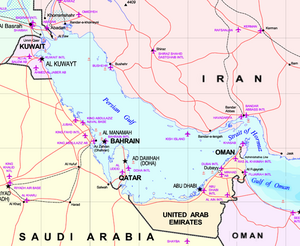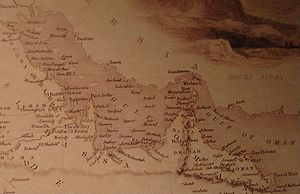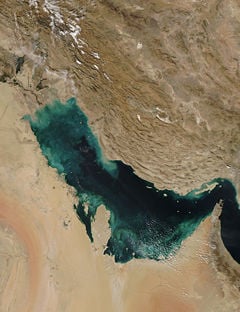Difference between revisions of "Persian Gulf" - New World Encyclopedia
Vicki Phelps (talk | contribs) |
Vicki Phelps (talk | contribs) |
||
| Line 49: | Line 49: | ||
In the travel account of [[Pythagoras]], several chapters are related to description of his travels accompanied by [[Darius the Great]], to [[Susa]] and [[Persepolis]], and the area is described. From among the writings of others in the same period, there is an inscription and engraving of Darius the Great in which he named the Persian Gulf water channel ''Pars Sea''. | In the travel account of [[Pythagoras]], several chapters are related to description of his travels accompanied by [[Darius the Great]], to [[Susa]] and [[Persepolis]], and the area is described. From among the writings of others in the same period, there is an inscription and engraving of Darius the Great in which he named the Persian Gulf water channel ''Pars Sea''. | ||
| − | ==Naming dispute== | + | ===Naming dispute=== |
| − | [[Image:Persian-gulf-dubai-mus.JPG|thumb|300px|A historical map of the Persian Gulf in | + | [[Image:Persian-gulf-dubai-mus.JPG|thumb|300px|A historical map of the Persian Gulf in a Dubai museum, [[United Arab Emirates]] with the word ''Persian'' removed.]] |
| − | + | With the rise of [[Arab]] [[nationalism]] ([[Pan-Arabism]]) in the 1960s, some Arab states of the region started adopting the term "Arabian Gulf" to refer to the waterway. However, this usage has not found much acceptance outside the Arab world and is not recognized by the [[United Nations]] or any other international organization. The United Nations Secretariat on many occasions has requested that only "Persian Gulf" be used as the official and standard geographical designation for the body of water. At the same time, the historical veracity of the usage of "Persian Gulf" can be established from the works of many [[medieval]] historians. | |
| − | With the rise of Arab nationalism ([[Pan-Arabism]]) in the 1960s, some Arab states of the region started adopting the term "Arabian Gulf" | ||
| − | |||
| − | |||
== History== | == History== | ||
Revision as of 17:57, 8 January 2009
| Persian Gulf | |
|---|---|
| Location | Southwest Asia |
| Ocean type | Gulf |
| Primary sources | Sea of Oman |
| Basin countries | Iran, Iraq, Kuwait, Saudi Arabia, Qatar, Bahrain, United Arab Emirates and Oman (exclave of Musandam) |
| Max length | 989 km |
| Max width | 56 km (min) |
| Surface area | 251,000 km2 |
| Average depth | 50 m |
| Max depth | 90 m |
The Persian Gulf, in the Southwest Asian region, is an extension of the Indian Ocean located between Iran and the Arabian Peninsula. Historically and commonly known as the Persian Gulf, this body of water is sometimes controversially referred to as the Arabian Gulf by certain Arab countries or simply The Gulf, although neither of the latter two terms is recognized internationally.
The Persian Gulf was a focus of the 1980-1988 Iraq-Iran War, in which each side attacked the other's oil tankers. In 1991, the gulf gave its name to the U.S.-led ejection of Iraqi forces from Kuwait, called the Persian Gulf War or the Gulf War even though most of the action took place on land.
The Persian Gulf is rich with good fishing grounds, extensive coral reefs, and abundant pearl oysters, but its ecology has come under pressure from industrialization, in particular, repeated petroleum spillages during recent wars.
Geography
This inland sea of some 251,000 km² is connected to the Gulf of Oman in the east by the Strait of Hormuz. Its western end is marked by the major river delta of the Shatt al-Arab, which carries the waters of the Euphrates and Tigris rivers. Its length is 989 kilometers, with Iran occupying most of the northern coast and Saudi Arabia most of the southern coast. The gulf is about 56 kilometers wide at its narrowest, in the Strait of Hormuz. The waters are overall very shallow, with a maximum depth of 90 meters and an average depth of 50 meters.
Countries with a coastline on the Persian Gulf are (clockwise, from the north): Iran, Oman (exclave of Musandam), United Arab Emirates, Saudi Arabia, Qatar on a peninsula off the Saudi coast, Bahrain on an island, Kuwait and Iraq in the northwest. Various small islands lie within the Persian Gulf, some of which are subject to territorial disputes by the states of the region.
Oil and gas
The Persian Gulf and its coastal areas are the world's largest single source of crude oil and related industries dominate the region. Al-Safaniya, the world's largest offshore oilfield, is located in the Persian Gulf. Large gas finds have also been made, with Qatar and Iran sharing a giant field across the territorial median line (North Field in the Qatari sector; South Pars Field in the Iranian sector). Using this gas, Qatar has built up a substantial liquified natural gas (LNG) and petrochemical industry.
The oil-rich countries (excluding Iraq) that have a coastline on the Persian Gulf are referred to as the Persian Gulf States. Iraq's egress to the gulf is narrow and easily blockaded, consisting of the marshy river delta of the Shatt al-Arab, which carries the waters of the Euphrates and Tigris Rivers, where the left (east) bank is held by Iran.
Etymology

In 330 B.C.E., the Achaemenid Empire established the first Persian Empire in Pars (Persis, or modern Fars) in the southwestern region of the Iranian plateau. Consequently in the Greek sources, the body of water that bordered this province came to be known as the Persian Gulf.
Considering the historical background of the name Persian Gulf, Sir Arnold Wilson mentions in a book published in 1928 that:
| “ | No water channel has been so significant as Persian Gulf to the geologists, archaeologists, geographers, merchants, politicians, excursionists, and scholars whether in past or in present. This water channel which separates the Iran Plateau from the Arabia Plate, has enjoyed an Iranian Identity since at least 2200 years ago.[1] | ” |
No written deed has remained since the era before the Persian Empire, but in the oral history and culture, the Iranians have called the southern waters: "Jam Sea," "Iran Sea," or "Pars Sea."
During the years 550 to 330 B.C.E., coinciding with sovereignty of the first Persian Empire in the Middle East, the name of "Pars Sea" was widely written in the compiled texts. when referring to the whole part of the Persian Gulf and some parts of the Arabian Peninsula.
In the travel account of Pythagoras, several chapters are related to description of his travels accompanied by Darius the Great, to Susa and Persepolis, and the area is described. From among the writings of others in the same period, there is an inscription and engraving of Darius the Great in which he named the Persian Gulf water channel Pars Sea.
Naming dispute

With the rise of Arab nationalism (Pan-Arabism) in the 1960s, some Arab states of the region started adopting the term "Arabian Gulf" to refer to the waterway. However, this usage has not found much acceptance outside the Arab world and is not recognized by the United Nations or any other international organization. The United Nations Secretariat on many occasions has requested that only "Persian Gulf" be used as the official and standard geographical designation for the body of water. At the same time, the historical veracity of the usage of "Persian Gulf" can be established from the works of many medieval historians.
History
{{#invoke:Message box|ambox}}
Pre-Islamic era
For most of the history of human settlement in the Persian Gulf the southern side was ruled by nomadic tribes. During the end of fourth millennium B.C.E. the southern part of the Persian Gulf was dominated by the Dilmun civilization. For a long time the most important settlement on the southern coast of the Persian Gulf was Gerrha. In the second century the Lakhum tribe, who lived in Yemen, migrated north and founded the Lakhmid Kingdom along the southern coast. During the 7th century the Sassanid Empire conquered the whole of the Persian Gulf.
Between 625 B.C.E. and 226 C.E. the northern side was dominated by the Median, Achaemenid, Seleucid and Parthian empires. After the fall of the Parthian Empire, the Sassanid empire ruled the northern half and at times the southern half of the Persian Gulf. the Persian Gulf, along with the Silk Road was very important to trade in the Sassanid empire. Siraf was an ancient Sassanid port that was located on the north shore of the Persian Gulf in what is now the Iranian province of Bushehr.
Colonial era
Portuguese expansion into the Indian Ocean in the early sixteenth century following Vasco da Gama's voyages of exploration saw them battle the Ottomans up the coast of the Persian Gulf. In 1521, a Portuguese force led by commander Antonio Correia invaded Bahrain to take control of the wealth created by its pearl industry. In 1602, Shāh ‘Abbās expelled the Portuguese from Bahrain.[2] With the support of the British fleet, in 1622 'Abbās took the island of Hormuz from the Portuguese: much of the trade was diverted to the town of Bandar 'Abbās which he had taken from the Portuguese in 1615 and had named after himself. The Persian Gulf was therefore opened to a flourishing commerce with Portuguese, Dutch, French, Spanish and British merchants, which were granted particular privileges.
From 1763 until 1971, the British Empire maintained varying degrees of political control over some Persian Gulf states, including the United Arab Emirates (originally called the "Trucial Coast States"[citation needed]) and at various times Bahrain, Kuwait, Oman, and Qatar through the British Residency of the Persian Gulf.
The United Kingdom maintains a high profile in the region; in 2006, over 1 million Britons visited Dubai alone.[3]
Wildlife
Mangroves in the Persian Gulf, which are thought to require tidal flow and a combination of fresh and salt water, are nurseries for crabs, small fish and insects - and the birds that eat them.[4]
See also
- Cradle of civilization
- Deluge (prehistoric)
- Gulf of Aden
ReferencesISBN links support NWE through referral fees
- ↑ Working Paper No. 61, UNITED NATIONS GROUP OF EXPERTS ON GEOGRAPHICAL NAMES, dated March 28, April 4, 2006 ([1]); accessed February 09, 2007
- ↑ Juan R. I. Cole, "Rival Empires of Trade and Imami Shiism in Eastern Arabia, 1300-1800," p. 186, through JSTOR. [2]
- ↑ Peter Beaumont, "Blair was dangerously off target in his condemnation of Iran", The Guardian, December 24, 2006.
- ↑ Jim Krane (2006-07-03). Development in Persian Gulf Threatens Wildlife. Discovery Channel.
External links
- Persian Gulf Studies website
- The Persian Gulf, Information, history and resources of the Persian Gulf
- The Portuguese in the Arabian peninsula and in the Persian Gulf
- Persian Gulf Region
- Publication of Historical Maps of the Persian Gulf in Tehran
- Persian Gulf maps
- Factsheet on the Legal and Historical Usage of the "Persian Gulf" - ISG MIT
- The Persian Gulf: The Politics of Geographic Renaming
- UN GEGN – Historical, Geographical and Legal Validity of the Name: Persian Gulf
- Persian Gulf Picture Gallery
- "Omission of 'Persian Gulf' Name Angers Iran," by Niusha Boghrati, Worldpress.org correspondent, December 28, 2006
Coordinates:
Credits
New World Encyclopedia writers and editors rewrote and completed the Wikipedia article in accordance with New World Encyclopedia standards. This article abides by terms of the Creative Commons CC-by-sa 3.0 License (CC-by-sa), which may be used and disseminated with proper attribution. Credit is due under the terms of this license that can reference both the New World Encyclopedia contributors and the selfless volunteer contributors of the Wikimedia Foundation. To cite this article click here for a list of acceptable citing formats.The history of earlier contributions by wikipedians is accessible to researchers here:
The history of this article since it was imported to New World Encyclopedia:
Note: Some restrictions may apply to use of individual images which are separately licensed.

